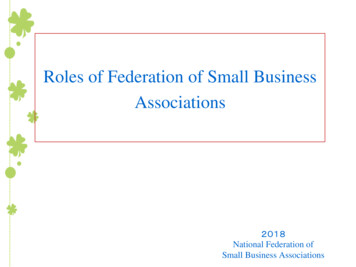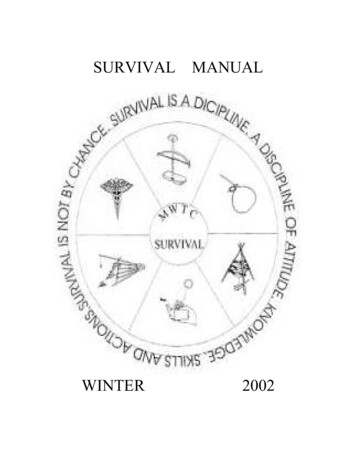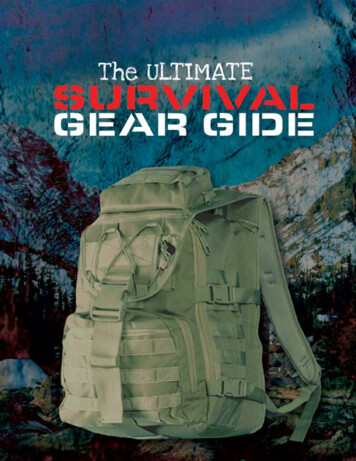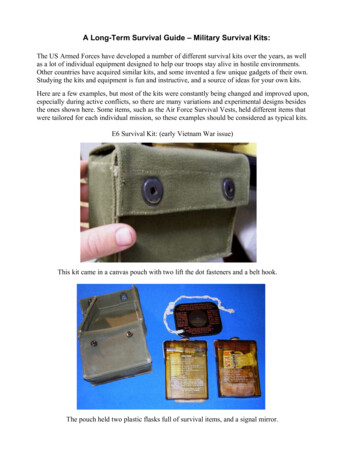
Transcription
SURVIVAL,EVASION, ANDRECOVERYMULTI-SERVICETACTICS,TECHNIQUES, ANDPROCEDURES FORSURVIVAL, EVASION,AND RECOVERYFM 3-50.3NTTP 3-50.3AFTTP(I) 3-2.26MARCH 2007DISTRIBUTION RESTRICTION: Distributionauthorized to DOD and DOD contractors only toprotect technical or operational information fromautomatic dissemination under the internationalExchange Program or by other means. Thisdetermination was made on 23 June 2006.Other requests will be referred to:HQ TRADOC, ATTN: ATFC-EJ, Ft Monroe, VA23651-1067;NWDC, ATTN: N5, Newport, RI 02841-1207; orHQ AFDC, ATTN: DD, Maxwell AFB, 36112-6112.DESTRUCTION NOTICE: Destroy by any methodthat must prevent disclosure of contents orreconstruction of the document.
FOREWORDThis publication has been prepared under our direction for useby our respective commands and other commands as appropriate.RICHARD J. ROWE, JR.Major General, US ArmyDeputy Director/Chief of StaffArmy Capabilities Integration CenterTIMOTHY L. DAVISONCaptain, US NavyCommander, ActingNavy Warfare Development CommandALLEN G. PECKMajor General,CommanderAir Force Doctrine CenterThis publication is available through the ALSAWeb site (www.alsa.mil); through the Army atArmy Knowledge Online (AKO)(www.us.army.mil) and at the General DennisJ. Reimer Training and Doctrine Digital Library(www.train.army.mil) Web sites; and throughthe Air Force at the Air Force Publishing Website (www.e-publishing.af.mil).
QUICK REFERENCE CHECKLISTFIVE PHASES OF EVASION1. Immediate Actions—THINK BEFORE YOU ACT!a. Assess immediate situation.b. Assess medical condition; treat as necessary (chapter V).c. Take action to protect from chemical, biological, radiological,and nuclear hazards (chapter IX).d. Gather equipment; move to initial hole-up/hide site.e. Make initial radio contact in accordance with (IAW) combatsearch and rescue/special instructions (CSAR/SPINS).f. Sanitize uniform of compromising information.g. Sanitize area; hide equipment you decide to leave.h. Apply initial personal camouflage.2. Initial Movementa. Move in the direction of your evasion plan of action (EPA), ifpossible.b. Attempt to break line of sight from your initial isolating areaand move uphill if possible.c. Move out of area, zigzag pattern recommended.d. Use terrain and concealment to your advantage.e. Move to hole-up/hide site.3. Hole-Up/Hide Sitea. Select hole-up/hide site that provides:(1) Concealment from ground and air searches.(2) Safe distance from enemy positions and lines ofcommunications (LOCs).(3) Listening and observation points.(4) Multiple avenues of escape.(5) Protection from environment.(6) Communications/signaling.b. Be prepared to authenticate IAW CSAR/SPINS.c. Establish radio contact IAW CSAR/SPINS.(Communications/signaling devices may compromise position.)20 March 2007FM 3-50.3/NTTP 3-50.3/AFTTP(I) 3-2.26i
d. Drink water; treat injuries for long term.e. Evaluate combat needs.f. Inventory equipment.g. Review and execute your EPA.h. Determine specific location.i.Improve camouflage.j.Stay alert, maintain security, and be flexible.4. Evasion Movement (Chapters I and II)a. Travel slowly and deliberately. (You are more at risk duringmovement.)b. Do not leave evidence of travel.c. Use noise and light discipline.d. Stay away from LOCs.e. Stop, look, listen, and smell.f. Move from one point of concealment to another point ofconcealment.g. Use evasion movement techniques (chapter I).5. Recovery (Chapters III and IV)a. Prepare for conventional or unconventional recovery.b. Select best area and prepare for use of communications andsignaling devices.c. Prepare to transmit position (range and bearing).d. Select site(s) IAW criteria in theater recovery plans.e. Observe/report enemy activity and hazards.f. Secure equipment.g. Stay concealed until recovery is imminent.h. Be prepared to authenticate via DD Form 1833, IsolatedPersonnel Report (ISOPREP) card.i.During recovery:(1) Follow recovery force instructions.(2) Secure weapon.(3) Assume non-threatening posture.(4) Beware of rotors/propellers.iiFM 3-50.3/NTTP 3-50.3/AFTTP(I) 3-2.2620 March 2007
*FM 3-50.3NTTP 3-50.3AFTTP(I) 3-2.26FM 3-50.3NTTP 3-50.3AFTTP(I) 3-2.26US Army Training and Doctrine CommandFort Monroe, VirginiaNavy Warfare Development CommandNewport, Rhode IslandHeadquarters, Air Force Doctrine CenterMaxwell Air Force Base, Alabama20 March 2007SURVIVAL, EVASION, AND RECOVERYMULTI-SERVICE TACTICS, TECHNIQUES, ANDPROCEDURESFOR SURVIVAL, EVASION, AND RECOVERYTABLE OF CONTENTSPageQUICK REFERENCE CHECKLIST . iCHAPTER IEVASION.I-1Planning .I-1Camouflage.I-1Shelters.I-3Movement .I-3CHAPTER IINAVIGATION.II-1Stay or Move Considerations .II-1Determine Navigation and Position .II-2Travel Considerations .II-9River Travel.II-9Ice and Snow Travel .II-9DISTRIBUTION RESTRICTION: Distribution authorized to DOD and DOD contractors only to protecttechnical or operational information from automatic dissemination under the international ExchangeProgram or by other means. This determination was made on 23 June 2006. Other requests will bereferred to:HQ TRADOC, ATTN: ATFC-EJ, Ft Monroe, VA 23651-1067;NWDC, ATTN: N5, Newport, RI 02841-1207; orHQ AFDC, ATTN: DD, Maxwell AFB, 36112-6112.DESTRUCTION NOTICE: Destroy by any method that must prevent disclosure of contents orreconstruction of the document.* This publication supersedes FM 3-50.3/NTTP 3-50.3/AFTTP(I) 3-2.26, 19 March 2003.20 March 2007FM 3-50.3/NTTP 3-50.3/AFTTP(I) 3-2.26iii
Mountain Hazards. II-11Dry Climates . II-11Tropical Climates . II-11Open Seas. II-12CHAPTER IIIRADIO COMMUNICATION ANDSIGNALING. III-1Radio Communications (Voice andData) . III-1Signaling . III-2CHAPTER IVRECOVERY.IV-1Responsibilities.IV-1Initial Actions.IV-1Actions on the Ground/in the Water .IV-1Site Selection.IV-2Prepare for Recovery.IV-2Communicate with Recovery Force .IV-2General Principles of Recovery.IV-3Unassisted Recovery.IV-3Assisted Recovery .IV-5CHAPTER VSURVIVAL MEDICINE .V-1Immediate First Aid Actions .V-1Common Injuries and Illnesses .V-5Plant Medicine .V-9Health and Hygiene .V-12Rules for Avoiding Illness.V-12CHAPTER VIPERSONAL PROTECTION .VI-1Priorities.VI-1Care and Use of Clothing.VI-1Other Protective Equipment .VI-2Shelters .VI-3Fires.VI-8CHAPTER VIIWATER .VII-1Water Requirements .VII-1Signs and Symptoms of Dehydration.VII-1Water Procurement.VII-1Water Preparation and Storage .VII-7CHAPTER VIIIFOOD .VIII-9Food Requirements .VIII-9Food Preparation .VIII-15ivFM 3-50.3/NTTP 3-50.3/AFTTP(I) 3-2.2620 March 2007
Food Preservation. VIII-17CHAPTER IXINDUCED CONDITIONS . IX-1Nuclear Conditions. IX-1Biological Conditions. IX-6Chemical Conditions . IX-6APPENDICESA. The Will to Survive. A-1B. Publication Information . B-1GLOSSARY. Glossary-1FIGURESFigure I-1. Camouflage Patterns .I-2Figure II-1. Stick and ShadowMethod to Determine North/SouthLine.II-2Figure II-2. Wristwatch Method toDetermine North/South Line .II-3Figure II-3. Celestial Aids (Stars)Method to Determine North/SouthLine.II-3Figure II-4. Map Orientation with aDial or Needle Compass.II-4Figure II-5. Map Orientation with aCompass Rose .II-5Figure II-6. Triangulation .II-6Figure II-7. Setting the Compass forNight Navigation .II-7Figure II-8. Dogleg and 90-DegreeOffset.II-8Figure II-9. Improvised Snowshoes .II-10Figure III-1. Radio TransmissionCharacteristics.III-1Figure III-2. Size and Ratio.III-3Figure III-3. Signal Key.III-3Figure IV-1. Rescue Strap. IV-4Figure IV-2. Forest Penetrator. IV-4Figure IV-3. Fixed Loop. IV-5Figure V-1. Open Airway . V-120 March 2007FM 3-50.3/NTTP 3-50.3/AFTTP(I) 3-2.26v
Figure V-2. Combat-Application-Tourniquet .V-2Figure V-3. QuickClot .V-3Figure V-4. Useful Plants.V-11Figure VI-1. Improvised Foot Wear.VI-2Figure VI-2. Sun and Snow Goggles .VI-3Figure VI-3. Gaiters .VI-3Figure VI-4. Immediate Shelters .VI-4Figure VI-5. Thermal A-Frame.VI-5Figure VI-6. Snow Trench.VI-5Figure VI-7. Snow Cave .VI-6Figure VI-8. Poncho/Parachute ShadeShelter.VI-7Figure VI-9. Elevated Platform Shelter .VI-7Figure VI-10. Shingle Method .VI-8Figure VI-11. Tepee Fire and Log CabinFire.VI-9Figure VI-12. Sod Fire and Reflector .VI-10Figure VI-13. Dakota Fire Hole .VI-10Figure VII-1. Water Procurement.VII-2Figure VII-2. Water Indicators.VII-3Figure VII-3. Banana Plants.VII-4Figure VII-4. Water Vines .VII-5Figure VII-5. Beach Well.VII-5Figure VII-6. Transpiration Bag.VII-6Figure VII-7. Vegetation Bag .VII-6Figure VII-8. Seepage Basin.VII-7Figure VIII-1. Snare Placement .VIII-9Figure VIII-2. Locking Loop.VIII-10Figure VIII-3. Squirrel Pole .VIII-10Figure VIII-4. Funneling .VIII-11Figure VIII-5. Procurement Devices.VIII-12Figure VIII-6. Procurement Methods.VIII-12Figure VIII-7. Small Game Skinning .VIII-16Figure IX-1. Immediate Action Shelter .IX-1Figure IX-2. Improvised Shelter .IX-2Figure IX-3. Radiation Shielding Efficiencies .IX-3Figure IX-4. Filtration Systems, FilteringWater .IX-4Figure IX-5. Filtration Systems, SettlingWater .IX-4viFM 3-50.3/NTTP 3-50.3/AFTTP(I) 3-2.2620 March 2007
Chapter IEVASION1,000 days of evasion are better than one day of captivity.1. Planninga. Review the quick reference checklist at the front of thispublication.b. Follow these guidelines for successful evasion:(1) Keep a positive attitude.(2) Use established procedures.(3) Follow your EPA.(4) Maintain radio discipline.(5) Be patient.(6) Drink water (DO NOT eat food without water).(7) Conserve strength for critical periods.(8) Rest and sleep as much as possible.(9) Stay out of sight.c. Avoid food, perfumes, or any other odors that may stand outand give you away.d. Mask scent using natural materials such as dirt orvegetation.e. Determine where to go IAW theater recovery plans:(1) Near a suitable area for recovery.(2) Selected area for evasion.(3) Neutral or friendly country or area.(4) Designated area for recovery.2. Camouflagea. Basic principles:(1) Disturb the area as little as possible.(2) Avoid activity that reveals movement to the enemy.(3) Apply personal camouflage.b. Camouflage patterns should match environment (figure I-1):20 March 2007FM 3-50.3/NTTP 3-50.3/AFTTP(I) 3-2.26I-1
(1) Face. Use dark colors on high spots and light colors onany remaining exposed areas. Use a hat, netting, or mask ifavailable.(2) Ears. The insides and the backs should have two colorsto break up outlines if not covered.(3) Head, Neck, Hands, and Under Chin. Use scarf, collar,vegetation, netting, or coloration methods.(4) Light-colored Hair / No Hair. Give special attention toconceal with a scarf or mosquito head net.Figure I-1. Camouflage Patternsc. Position and movement camouflage:(1) Avoid unnecessary movement.(2) Take advantage of natural concealment:(a) Cut foliage fades and wilts; change regularly.(b) Change camouflage depending on the surroundings.(c) DO NOT select all vegetation from same source.(d) Use stains from grasses, berries, dirt, and charcoal.(3) DO NOT overcamouflage.(4) Remember when using shadows, they shift with the sun.(5) Never expose shiny objects (i.e., watches, glasses, pens,boots).(6) Ensure watch alarms and hourly chimes are turned off.(7) Remove unit patches, name tags, rank insignia, and soforth.(8) Break up the outline of the body—“V” of crotch/armpits,head/shoulders.I-2FM 3-50.3/NTTP 3-50.3/AFTTP(I) 3-2.2620 March 2007
(9) Observe from a prone and concealed position.3. Sheltersa. Use camouflage and concealment.b. Locate carefully—remember the acronym: BLISS.c. Choose an area with observable approach and escapeB – Blend (blend with environment).L – Low silhouette (smaller than surroundings).I – Irregular shape (natural looking).S – Small (enough for you and your gear).S – Secluded location (least likely to be searched).routes.d. Use brush, ridges, ditches, and rocks to keep from formingpaths to hole-up/hide site.e. Be wary of natural hazards such as flash floods in ravinesand canyons.f. Conceal with minimal to no preparation.g. Ensure overhead concealment.h. Attempt to return the area to its original state before you startyour movement.4. Movementa. A moving object is easy to spot. If travel is necessary:(1) Mask with natural cover.(2) Stay off ridgelines, use the "military crest" (2/3 of the wayup) of a hill.(3) Restrict to periods of low light, bad weather, wind, orreduced enemy activity.(4) Avoid silhouetting.(5) At irregular intervals:(a) STOP at a point of concealment.(b) LOOK, LISTEN, and SMELL for signs of human oranimal activity. Watch for trip wires or booby traps and avoidleaving evidence of travel. Peripheral vision is more effective forrecognizing movement at night and twilight.20 March 2007FM 3-50.3/NTTP 3-50.3/AFTTP(I) 3-2.26I-3
b. Camouflage evidence of travel. Route selection requiresdetailed planning and special techniques (irregular route/zigzag).c. Concealing evidence of travel:(1) DO NOT break branches, leaves, or grass. Use a walkingstick to part vegetation and push it back to its original position.(2) DO NOT grab small trees or brush. (This may scuff thebark or create movement that is easily spotted. In snow country,this creates a path of snowless vegetation.(3) Pick firm footing. TRY NOT TO:(a) Overturn ground cover, rocks, and sticks.(b) Scuff bark on logs and sticks.(c) Make noise by breaking sticks. (Cloth wrappedaround feet helps muffle noise.)(d) Mangle grass and bushes that normally spring back.(4) Mask unavoidable tracks in soft footing:(a) Place tracks in the shadows of vegetation, downedlogs, and snowdrifts.(b) Move before and during precipitation; allows tracksto fill in.(c) Travel during windy periods.(d) Take advantage of solid surfaces leaving lessevidence of travel.(e) Tie cloth or vegetation to feet or brush / pat outtracks lightly to speed their breakdown or make them look old.(5) Secure trash and loose equipment; hide or bury discardeditems.(6) If pursued by dogs, concentrate on defeating the handler.(a) Travel downwind of dog/handler, if possible.(b) Travel over rough terrain and/or through densevegetation to slow the handler.(c) Travel downstream through fast moving water.(d) Zigzag route if possible; consider loop-backs and “J”hooks.d. Penetrate obstacles as follows:(1) Enter deep ditches feet first to avoid injury.I-4FM 3-50.3/NTTP 3-50.3/AFTTP(I) 3-2.2620 March 2007
(2) Go around chain-link and wire fences. Go under fence ifunavoidable, crossing at damaged areas. DO NOT touch fence;look for electrical insulators or security devices.(3) Penetrate rail fences, passing under or between lowerrails. If this is impractical, go over the top, presenting as low asilhouette as possible.(4) Cross roads after observation from concealment todetermine enemy activity. Cross at points offering concealmentsuch as bushes, shadows, or bend in road. Cross in a mannerleaving footprints parallel to the road (do this by steppingsideways).(5) Use same method of observation for railroad tracks asused for roads. Then, lower your body to the ground aligningparallel to the tracks with face down. Cross the tracks using asemi-pushup motion moving sideways.Warning: If there are three rails, one may be electrified.e. Urban considerations:(1) Look for and move to “friendly” controlled location orstronghold point.(2) Avoid movement into market-type areas and crowds.(3) Avoid high rise buildings.(4) Head to concealment to break visual contact.(5) If seen, change direction radically.(6) Use caution when passing windows and doors; try toavoid.(7) Use cloth, rags, clothing, and other man-made material toblend in.(8) Conceal movement utilizing buildings, rubble, and otherstructures.(9) Observe structures for movement or life threateningobstacles.20 March 2007FM 3-50.3/NTTP 3-50.3/AFTTP(I) 3-2.26I-5
THIS PAGE INTENTIONALLY LEFT BLANK
Chapter IINAVIGATIONAssess the threat and apply appropriate evasion principles.1. Stay or Move Considerationsa. Leave only when:(1) Dictated by the threat.(2) Certain of your location and your destination and you areable to get there.(3) Able to reach water, food, shelter, and/or help.(4) Convinced rescue is not coming.b. If you decide to move:(1) Follow your EPA.(2) Determine which direction to travel and why.(3) Decide what equipment to take, cache, or destroy.(4) It is usually better to move at night because of theconcealment darkness offers. Exceptions to such movement wouldbe when moving through hazardous terrain or dense vegetation(e.g., jungle or mountainous terrain). Stop movement with sufficienttime to find concealment and shelter prior to sunrise.c. Avoid compromising information when using a map in acombat environment:(1) DO NOT write on the map.(2) DO NOT soil the map by touching the destination.(3) DO NOT fold in a manner providing travel information.d. Considerations for non-combat:(1) Stay in place (e.g., with vehicle).(2) If you do not stay in place, leave information at yourstarting point that includes:(a) Destination and route of travel.(b) Personal condition.(c) Supplies available.20 March 2007FM 3-50.3/NTTP 3-50.3/AFTTP(I) 3-2.26II-1
2. Determine Navigation and Positiona. Determine general location.Note: Determine best guess direction based on previousknowledge when navigating without a map, globalpositioning system (GPS), or compass (e.g.,movement is east toward the border).(1) Develop working knowledge of operational area.(a) Geographic checkpoints.(b) Man-made checkpoints.(c) Previous knowledge of operational area.(2) Use formula: Rate x Time Distance.(3) Use information provided in map legend.(4) Use prominent landmarks.(5) Visualize map to determine position.b. Determine cardinal directions (north, south, east, and west).(1) Use compass.(2) Use stick and shadow method to determine a truenorth/south line (figure II-1).Figure II-1. Stick and Shadow Method to DetermineNorth/South Line(3) Remember the sunrise/moonrise is in the east andsunset/moonset is in the west.(4) Use wristwatch to determine general cardinal direction, ifcurrent local time is known (figure II-2). With digital watches,visualize a clock face on the watch.II-2FM 3-50.3/NTTP 3-50.3/AFTTP(I) 3-2.2620 March 2007
Figure II-2. Wristwatch Method to Determine North/SouthLine(5) Use stars (figure II-3).Figure II-3. Celestial Aids (Stars) Method to DetermineNorth/South Linec. To orient the map:(1) Use a true north-south line (figure II-4).(a) Unfold map and place on firm, flat, level nonmetallicsurface.(b) Align compass on true north-south line.(c) Rotate map and compass until stationary index linealigns with the magnetic variation indicated in marginal information.20 March 2007 Easterly (subtract variation from 360 degrees). Westerly (add variation to 360 degrees).FM 3-50.3/NTTP 3-50.3/AFTTP(I) 3-2.26II-3
Figure II-4. Map Orientation with a Dial or Needle Compass(2) Use a compass rose (figure II-5).(a) Place edge of the compass on magnetic north line ofthe compass rose closest to your location.(b) Rotate map and compass until compass reads 360degrees.II-4FM 3-50.3/NTTP 3-50.3/AFTTP(I) 3-2.2620 March 2007
Figure II-5. Map Orientation with a Compass Rose(3) If there is NO compass, orient map using cardinaldirection, obtained by the stick and shadow method or the celestialaids (stars) method.d. Determine specific location (be prepared to give coordinatesand datum to rescue forces if asked).(1) Using GPS and map.(a) More sky better accuracy and quicker positionacquisition.(b) More frequent position fixes shorter time to acquirenext position.(c) Watch for jamming and interference. GPS satellitesignals are very susceptible to jamming and interference.Indications include: Continuous, one-directional “marching”—receiver shows a continuous “marching” of latitude or longitude (forexample the value continuously increases or decreases in a singledirection). Obviously incorrect position data—you knowyour rough position but your GPS receiver shows a location that is20 March 2007FM 3-50.3/NTTP 3-50.3/AFTTP(I) 3-2.26II-5
significantly and obviously incorrect (for example you know you arein Iraq but your receiver shows 0 degrees latitude and 5 degreeslongitude). “Jumping” position data —receiver positionjumps between significantly different positions (for example morethan a tenth of a degree at a time). Unexpected loss of position lock—receiverhas good view of the sky and good power supply and is operatingnormally, but cannot maintain position lock or is unexpectedlyknocked off a position lock.(d) Protect against jamming and interference.Determine relative location of jamming and block jamming by usingbody/structure shielding from jamming signal, placing GPS receiverin a hole (16”x12”) or building a wall (18”x14”) between GPSreceiver and jammer.(e) Conserve GPS battery life.(2) Triangulation (resection) with a compass (figure II-6).(a) Try to use three or more azimuths (between 30 and130 degrees apart).(b) Positively identify a major land feature anddetermine a line of position (LOP).(c) Check map orientation each time compass is used.(d) Plot the LOP using a thin stick or blade of grass(combat) or pencil line (non-combat).(e) Repeat steps (b) through (d) for other LOPs.Figure II-6. Triangulatione. Use the compass for night navigation by:(1) Setting up compass for night navigation (figure II-7).II-6FM 3-50.3/NTTP 3-50.3/AFTTP(I) 3-2.2620 March 2007
(2) Aligning north-seeking arrow with luminous line and followfront of compass.(3) Using point-to-point navigation.Figure II-7. Setting the Compass for Night Navigationf. Use route selection techniques:(1) Circumnavigation.(a) Find a prominent landmark on the opposite side ofobstacle on current heading.(b) Contour around obstacle to landmark.(c) Resume your route of travel.(2) Dogleg and 90-degree offset (figure II-8).20 March 2007FM 3-50.3/NTTP 3-50.3/AFTTP(I) 3-2.26II-7
Figure II-8. Dogleg and 90-Degree Offset(3) Straight-line heading:(a) Maintain heading until reaching destination.(b) Track number of paces traveled to monitor progress. One pace is the distance covered each time thesame foot touches the ground. Distances measured by paces are approximate(for example: in open terrain, 65 paces per 100 meters [average]; inrough terrain or night, 90 to 100 paces per 100 meters). Keep track of your pace count (pebbles in pocketor knots in a string per 100 meters).(c) Use pace count with terrain evaluation and headingto determine location. Individual pace varies because of factorssuch as steep terrain, day/night travel, or injured/uninjuredcondition. Adjust estimation of distance traveled against thesefactors to get relative accuracy when using a pace count.(4) Deliberate offset:(a) Use when finding a point on a linear feature (that is,road or river).(b) Intentionally navigate to left or right of target so youknow which way to turn at the linear feature.(5) Point-to-point same as straight line:(a) Pick out landmarks on the heading and walk the trailof least resistance to a point.II-8FM 3-50.3/NTTP 3-50.3/AFTTP(I) 3-2.2620 March 2007
(b) On reaching a point, establish another landmark andcontinue.3. Travel Considerationsa. Maintain a realistic pace.b. Take rest stops when needed.c. Avoid overdressing and overheating.d. Consider food and water requirements.e. Take special care of feet (change socks regularly).f. Pack equipment to prevent loss, damage, pack imbalance,and personal safety.g. Go around obstacles, not over or through them.h. Avoid travel on trails, if possible.i.Travel in forested areas, if possible.j. Avoid creek bottoms and ravines with NO escape in theevent of heavy rains.k. Consider the following for swamps, lakes, and unfordablerivers:(1) Circumnavigate swamps, lakes, and bogs, if possible.(2) Travel downstream to find people and slower water.(3) Travel upstream to find narrower and shallow water.4. River TravelRiver travel may be faster and save energy when hypothermiais not a factor. It may be a primary mode of travel and LOC in atropical environment (use with caution if evading).a. Use flotation device (such as raft, log, bamboo) whencrossing rivers or large/deep streams.b. Use a pole to move the raft in shallow water and an oar indeep water.c. Keep near shore and stay near inside edge of river bends(current speed is less).d. Use caution when traveling on rivers; avoid submergedobjects, rapids, waterfalls, and hazardous animals.5. Ice and Snow Travela. Use caution while traveling in blizzards, poor visibility, andbitterly cold winds.20 March 2007FM 3-50.3/NTTP 3-50.3/AFTTP(I) 3-2.26II-9
b. Obstacles to winter travel include:(1) Deep soft snow; if movement is necessary, makesnowshoes (figure II-9). Travel is easier in early morning or lateafternoon near dusk when snow is frozen or crusted.Figure II-9. Improvised Snowshoes(2) Avoid avalanche prone areas:(a) Slopes 25 to 60 degrees.(b) Trees without uphill branches (identifies prioravalanches).(c) Heavy snow loading on ridge tops.(3) If caught in an avalanche:(a) Move perpendicular to hillside.(b) Use swimming motion to remain on or close tosurface.(c) Move hand around face to create air pocket asmoving snow slows.(4) Frozen water crossings.(a) Weak ice should be expected where:II-10 Rivers are straight. Objects protrude through ice. Snow banks extend over ice.FM 3-50.3/NTTP 3-50.3/AFTTP(I) 3-2.2620 March 2007
Rivers or streams come together. Water vapor rising indicates open or warm Air pockets form when a frozen river losesareas.volume.(b) When crossing frozen water, distribute your weightby laying flat, belly crawling, or using snowshoes.(c) Have long pole (to prevent total submersion) andknife or other pointed tools available to assist with self-recovery.c. Glacier travel is hazardous and should be avoided becauseof unseen hazards.6. Mountain Hazardsa. Lightning. Avoid ridge tops during thunderstorms.b. Avalanche. Avoid areas prone to avalanches/falling rocks.c. Flash Floods. Avoid creek bottoms, ravines, and wadis withno escape in the event of heavy rains.7. Dry Climatesa. Consider remaining in place unless certain of reachingdestination using water supply available.b. Travel at night to avoid heat.c. Stop movement with sufficient time to find concealment orconstruct shelter prior to sunrise.d. In sand dune areas:(1) Follow hard valley floor between dunes.(2) Travel on the windward side of dune ridges.e. If a sandstorm occurs:(1) Mark direction of travel.(2) Sit or lie down in direction of trave
FM 3-50.3 US Army Training and Doctrine Command Fort Monroe, Virginia NTTP 3-50.3 Navy Warfare Development Command Newport, Rhode Island AFTTP(I) 3-2.26 Headquarters, Air Force Doctrine Center Maxwell Air Force Base, Alabama 20 March 2007 SURVIVAL, EVASION, AND RECOVERY










